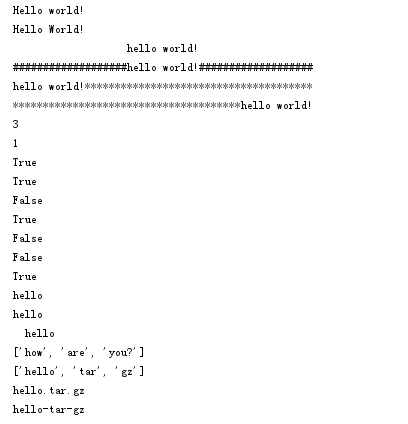py_str = 'hello world!'
print(py_str.capitalize()) # 第一个字母大写
print(py_str.title()) # 首字母大写
print(py_str.center(50)) # 字符串放50空格中间
print(py_str.center(50, '#')) # 字符串放50个*的中间
print(py_str.ljust(50, '*')) # 后面插入50个*
print(py_str.rjust(50, '*')) # 前面插入50个*
print(py_str.count('l')) # 统计l出现的次数,为3次
print(py_str.count('lo')) # 统计l0出现的次数,为1次
print(py_str.endswith('!')) # 以!结尾吗?
print(py_str.endswith('d!')) # 以d!结尾吗?
print(py_str.startswith('a')) # 以a开头吗?
print(py_str.islower()) # 字母都是小写的?其他字符不考虑
print(py_str.isupper()) # 字母都是大写的?其他字符不考虑
print('Hao123'.isdigit()) # 所有字符都是数字吗?
print('Hao123'.isalnum()) # 所有字符都是字母数字?
print(' hello\t '.strip()) # 去除两端空白字符,常用
print(' hello\t '.lstrip())
print(' hello\t '.rstrip())
print('how are you?'.split()) # 以空格分隔
print('hello.tar.gz'.split('.')) # 已点号分隔
print('.'.join(['hello', 'tar', 'gz'])) # 插入已点号为分隔
print('-'.join(['hello', 'tar', 'gz'])) # 插入以一横杠为分隔
结果输出:



